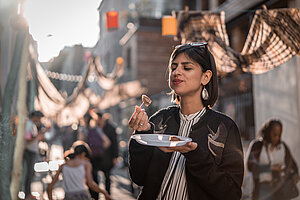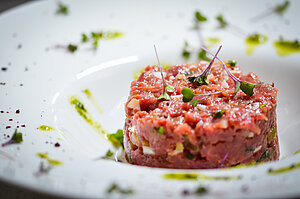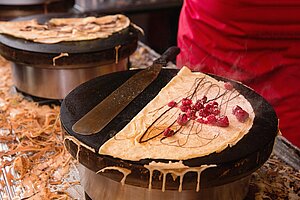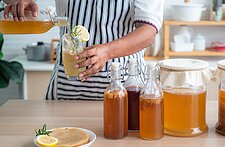During the Olympics, the coming together of international athletes and fans creates unique opportunities for those in the food industry to innovate, be seen, and create global trends.
What food trends dominated the Paris 2024 Summer Olympics? How have current trends, the influx of international visitors, and the global focus on this French city impacted the local food scene?
 Feeding a World of Visitors
Feeding a World of Visitors
Many Olympians took to social media during their time in France to share the traditional French dishes they sampled.
For example, American rugby player Ilona Maher famously celebrated winning a medal by touring the city’s patisseries to dive into French pastries, including a giant croissant. Norwegian swimmer Henrik Christiansen went viral with a series of TikTok videos detailing his love affair with the chocolate muffins served in the Olympic Village boulangerie.
French caterer Sodexo Live, contracted to manage food service at the Olympic Village, estimated it served 40,000 meals a day to 15,000 people. The company was tasked with creating 500 recipes for the event that included influences from French and world cuisine, along with sustainable (i.e., plant-based) options.
As for local restaurateurs, many remained true to their roots and had no trouble attracting crowds. Renowned brasserie Le Grand Colbert proudly served traditional steak tartare, escargot, and frogs’ legs among chandeliers and white tablecloths, while kosher Middle Eastern restaurant L’As du Fallafel offered shawarma, kebabs, and falafel to lines of diners snaking down the block.
Observing Current Trends
Modern-day French cuisine goes far beyond traditional fare, and the chefs who created menus for the Olympic Village were keen to highlight their takes on world cuisine, sustainable and health-conscious recipes, and the comfort appeal of the bustling street food scene.
Related: Join us for our Symrise Cross Category Trendscope 2024+ Webinar
 World Cuisine
World Cuisine
Catering to consumers hailing from over 200 countries is no easy feat, which is why Sodexo Live opted to focus on a variety of international cuisines, particularly Asian, Afro-Caribbean, and Middle Eastern, along with halal and kosher menus and plant-based takes on classics, such as vegetarian shawarma.
Sustainable and Health-Conscious Menus
Chefs took on the massive challenge of feeding thousands of people at the Olympic Village by creating a menu of creative gourmet fare with healthy dining in mind. The result was a public menu featuring about 60% meat-free dishes, while the menu for athletes offered 30% fully plant-based fare, along with a ban on disposable cutlery and plates.
Michelin-starred chef Alexandre Mazzia, born to French parents in the Republic of Congo, put his own spin on modern French cuisine with dishes like hake with tapioca, ground beef with licorice black rice, and risotto with green beans, blackberries, and blackcurrants.
Unfortunately, not all Olympians were pleased with the lack of staples like eggs and grilled meats, and some lamented the lack of French classics they were expecting.
Street Food Innovations
Many countries have long traditions of casual street food scenes that serve affordable local faves to working-class patrons and tourists alike, France among them. While the city banned street food vendors in the mid-20th century, the ban has been lifted, and recent years have seen an uptick in vendors offering everything from on-the-go crepes and empanadas to sandwiches and steak frites.
The à emporter (takeaway) revolution has not caught on with many Parisians, attracting mainly younger residents. However, it’s a big hit with visitors more accustomed to food trucks.
With an estimated 11 million extra people temporarily in the city, this portion of the dining landscape played an important role in keeping them fed. In the Olympic Village, “grab-and-go” stations mimicked the convenience of the street food style.
For more trends and exciting insights, sign up for our weekly newsletter HERE
 French Food Forecast
French Food Forecast
French cuisine is already looking toward a more sustainable future despite the heavy use of meat and animal products in the country’s traditional cuisine.
Although athletes may not have fully embraced the forward-thinking vision of the Olympic Village menu, the sustainable trend continues to gain momentum worldwide, so it’s likely to remain top-of-mind for those in the food industry long after the Olympic crowds disperse.
To learn more about Symrise, food trends and insights, contact the team today.





